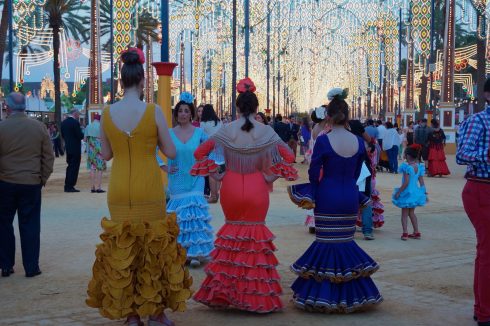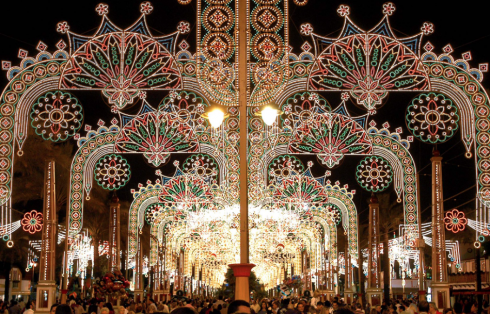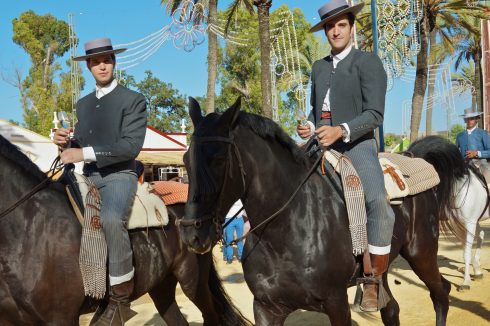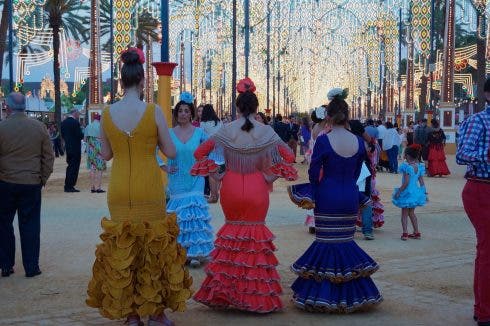To discover what makes Jerez tick, visit during the feria for a celebration of sherry, flamenco, dancing and fancy horses under a million lights.
Jerez de la Frontera is at the heart of the sherry triangle, the cradle of flamenco, and home to dancing horses. It’s also a city which knows how to party.
And there is no better way of finding out than at one of Spain’s most flamboyant ferias – the Feria del Caballo – which takes place from May 6 to 13… and everyone’s invited.

A glittering society event (albeit with some bawdy carousing in the early hours), Jerez’s feria started out in the traditional way as a horse fair in a field in the middle ages. Even then, ‘trading’ involved late night partying, and the occupants of surrounding houses risked being fined the equivalent of a euro if they failed to keep a lantern burning so the goings-on were illuminated.
Now, when someone important flicks the switch on May 8 at 10pm, Parque Gonzalez Hontoria, the vast fairground in the south of the city which, for most of the year, is a 52-hectare dark (square) roundabout, will be lit up (fuses allowing) by over 1.3 million points of light, strung in loops over elaborate arches like necklaces of dazzling jewels.

It’s a temporary town for the week, with 175 casetas (a superior alternative to hospitality tents), each hosted by a religious association or a winery, a business, or a social group – all of whom go all out with the decor, adding potted palms, terraces, window boxes, elaborate facades, and painted wooden chairs.
Most casetas (unlike Sevilla) are open to the public, and most will be serving food at some point. If not a guest of the aristocracy at a private catered feast, your choices are mainly limited to fried fish, calamares and papas aliñas on paper plates, but there’s also fabulous jamon and you can’t go wrong with that – unless you’re a vegetarian.
Each caseta has a bar where you can buy drinks, specifically Jerez sherry and rebujitos (sherry and lemonade), the feria classic down in these parts.

And all are guaranteed to have music playing loudly and, at what seems random times, live flamenco. Catching a performance here, among an audience of well-fuelled, passionate aficionados, is an unforgettable experience.
This year’s event is dedicated to flamenco fashion (a thriving creative industry) and the magnificent Lola Flores who was born in Jerez 100 years ago. The singer, dancer and star of the silver screen was what amounts to a national treasure and you will, for sure, be hearing multiple renditions of her greatest hit, Ay Pena, Penita, Pena.
The week starts fairly sedately (there are discounts for pensioners on the Monday), and builds to a grand finale with the biggest shows on Friday and Saturday. Choose which day to visit according to your tolerance for noise, passion and queues, but time it to coincide with the last hours of the Paseo de Jinetes y Caballos (held Monday-Saturday, 1pm-7.30pm) when hundreds of horses, riders, and carriage drivers circle the fairground, nodding to people before dusk and the lights go on.
Note: the opening hours are 1pm to dawn, Andalucia style.
There is a lot of horse action, much of it competitive and taking place in the Equisur area. Try to catch the displays of doma vaquera, a unique form of dressage rooted in cattle herding and wrangling out in the sierras, and involving fancy footwork on the part of the horse.
At the far end from the main entrance, there are fairground rides – a blindingly hot expanse of roaring generators and over excited children buying plastic things. Not for nothing is it called the Calle del Infierno (Street of Hell).
It’s not only the horses that parade around impeccable and proud to murmurs of admiration: the attendees do too: People come beautifully dressed – the women with flowers in their hair and stitched into full length dresses of vibrant hue and trailing flounces, and men in the traditional short jacketed suits in grey and blue with boater style hats. You can expect to see some impressive bandalero style sideburns, too.
It would be tempting to dress like that – but just don’t.
Etiquette
The Feria de Jerez is officially designated as being of international tourism interest, and hundreds of tourists visit each year and are warmly received, but there is an unspoken code of etiquette.
If you are a foreigner, unless going with friends from Jerez who absolutely demand you must, it’s not advisable to attempt wearing a full flamenco traje (outfit). Firstly, it’s hard to carry off; and secondly, flamenco dress is by no means a costume, but an extension of deep-rooted, local culture.
In Jerez – unlike at many ferias – you are welcome to squeeze into the casetas, and buy drinks and food at the bar. But don’t head to the best table – the casetas are there to enable the hosts to offer hospitality to their own family, friends and clients.
However much you enjoy the singing, don’t feel the need to join in, although the occasional, well-timed ole! may go down well.
How to get there
Parking at the feria site fills up early. There is limited street parking in the surrounding residential area, and usually a few pop-up car parks, but if driving to Jerez, your best bet is to park elsewhere and either walk, contact TeleTaxi (via WhatsApp +34 657 804 545), or try for an Uber.
There are budget airline flights to Jerez from all over Spain (and beyond), and plenty of longer distance trains and buses. A special feria bus service will be running from the train station, and shuttling people from the centre of Jerez to the fairground, a 10-minute drive away.

